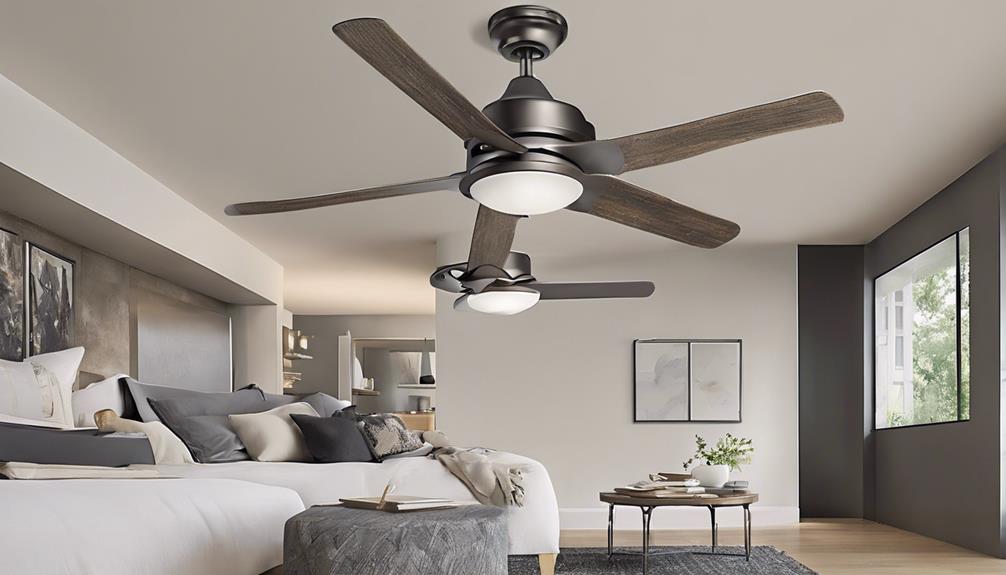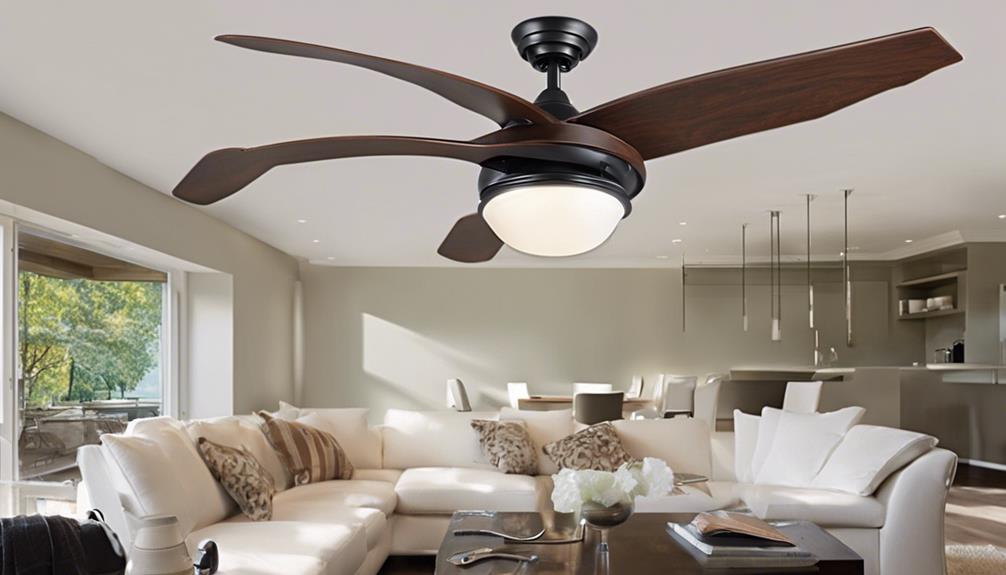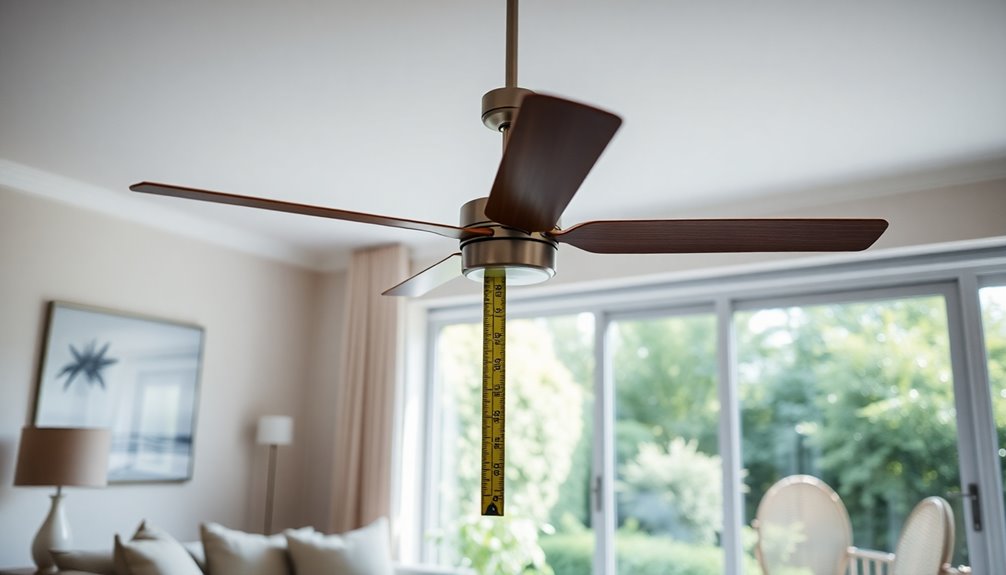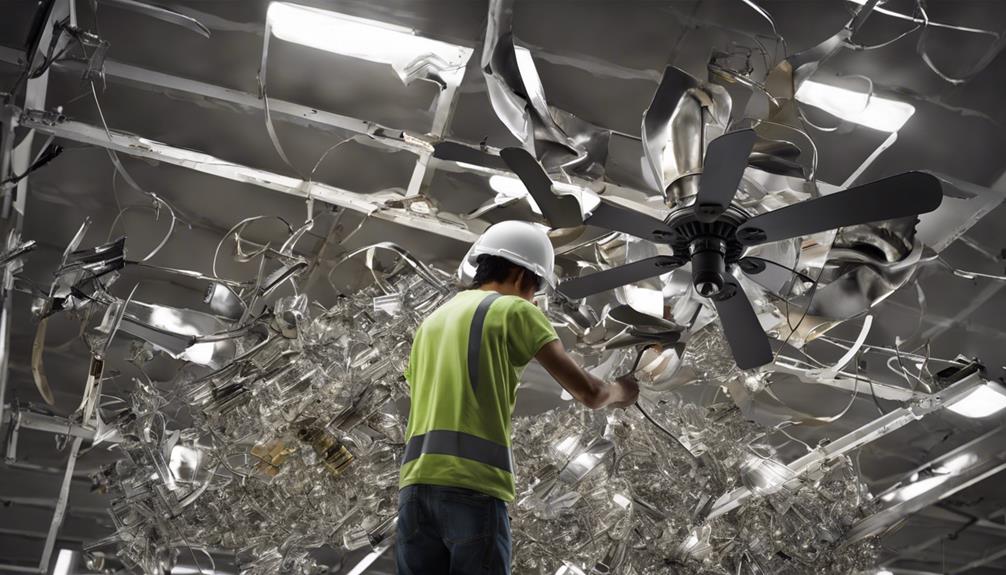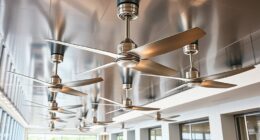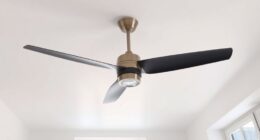When deciding between a flush mount and a downrod ceiling fan, it's essential to consider price, feature variability, ease of installation, air circulation efficiency, and noise levels. Downrod fans may be pricier due to design flexibility and additional components, while flush mount fans offer a sleek, modern look and easier installation. Downrod fans excel in air circulation, especially in larger rooms, while flush mount fans are more suitable for smaller spaces. Noise levels vary, with flush mount fans potentially amplifying vibrations and downrod fans operating more quietly with proper installation. These factors are crucial in choosing the best fan for your space's needs.
Key Takeaways
- Downrod fans offer superior air circulation for larger rooms.
- Flush mount fans have a sleek, modern look for smaller spaces.
- Flush mount fans are easier to install, ideal for DIY projects.
- Downrod fans operate quieter due to distance from ceiling.
- Choice depends on design preference, room size, and installation ease.
Price Considerations
When comparing flush mount and downrod ceiling fans, the price considerations reveal that downrod fans tend to be pricier due to their design flexibility and additional components. While flush mount fans are typically more affordable, downrod fans offer more design options and use additional materials, which contribute to their higher price point. The brand reputation also plays a role in the pricing, as certain brands may offer premium downrod fans at a higher cost. However, both options have budget-friendly selections available, allowing individuals to choose based on their financial constraints.
When considering the long-term benefits, the initial investment in a downrod fan may be justified by its enhanced design flexibility and potentially higher quality materials used. It's essential to weigh the upfront cost against the long-term advantages to make a well-informed decision. Ultimately, the choice between a flush mount and downrod ceiling fan depends on personal preferences, budget constraints, and the desired aesthetic for the space.
Feature Variability

With a focus on feature variability in ceiling fans, let's explore the diverse options available for both flush mount and downrod models. Downrod ceiling fans offer a wide range of design flexibility with various styles and finishes to match any decor style. These fans can accommodate different lighting options, such as integrated light kits or customizable fixtures, providing both functionality and aesthetics.
On the other hand, flush mount fans have a sleek and modern look, making them ideal for rooms with low ceilings or minimal clearance. Their direct attachment to the ceiling not only enhances the room's aesthetic but also makes installation and maintenance easier compared to downrod fans. Additionally, both flush mount and downrod fans may come equipped with reversible motor functionality, allowing for changing fan direction and airflow to suit different needs.
When considering ceiling fans, it's essential to weigh the features like design flexibility, lighting options, reversible motor functionality, and ease of installation and maintenance to choose the right fan for your space.
Ease of Installation
Installing a flush mount ceiling fan is straightforward and hassle-free compared to mounting a downrod fan. When considering the ease of installation between the two options, the following points become evident:
- Direct Attachment: With a flush-mount ceiling fan, you can directly attach the fan to the ceiling without the need for additional components like downrods.
- DIY Installation: Flush mount fans are designed for easy do-it-yourself installation, making it accessible for individuals looking to enhance their space without professional help.
- Ideal for Low Ceilings: For rooms with low ceilings, a flush mount fan offers a secure attachment without compromising on style or functionality.
Choosing a flush mount ceiling fan ensures a quick and seamless installation process, perfect for those seeking a hassle-free upgrade to their living spaces. Whether you're a seasoned DIY enthusiast or a beginner looking to embark on a home improvement project, the simplicity of a flush mount fan installation caters to your needs while providing a functional and stylish solution.
Air Circulation Efficiency

Optimizing air circulation efficiency is a key consideration when choosing between flush mount and downrod ceiling fans. Downrod ceiling fans, with their lower positioning from the ceiling, excel in air circulation compared to flush mount fans. The distance between the ceiling fan blades and the ceiling in downrod mounts allows for enhanced airflow, resulting in improved cooling effects, especially in larger rooms. For spaces with higher ceiling heights or areas where optimal air movement is essential, downrod ceiling fans are the preferred choice due to their superior airflow efficiency.
In contrast, flush mount fans are more suitable for smaller rooms with lower ceilings where air circulation efficiency may not be as critical. While they're effective in certain settings, flush mount fans aren't designed to provide the same level of air circulation as downrod fans. When considering the cooling and air movement needs of a room, the choice between flush mount and downrod ceiling fans can significantly impact the overall comfort and airflow efficiency within your living space.
Noise Level Assessment
Assessing noise levels is crucial when comparing flush mount and downrod ceiling fans for optimal performance and comfort in a living space. When evaluating the noise levels of ceiling fans, consider the following:
- Proximity to the Ceiling: Flush mount ceiling fans, being closer to the ceiling, may amplify vibrations and produce more operating noise.
- Fan Blade Distance: Downrod ceiling fans, with more distance between the fan blades and the ceiling, tend to operate more quietly.
- Quality of Installation: Proper installation and maintenance are key factors in reducing noise levels in both types of ceiling fans.
The fan motor quality and the installation process significantly influence how much noise a ceiling fan generates. By ensuring a well-installed and well-maintained fan, you can enjoy a quieter and more peaceful environment in your living space.
Frequently Asked Questions
Which Is Better Flush Mount or Downrod?
When choosing between flush mount and downrod ceiling fans, consider factors like room size, ceiling height, and airflow needs.
Flush mount fans are great for low ceilings, but downrod fans are better for taller spaces.
Downrod fans offer better air circulation, ideal for larger rooms.
Installation process, aesthetics, noise level, and maintenance should also influence your decision.
Remote control options can enhance convenience.
Ultimately, the choice depends on your specific requirements and preferences.
Are Flush Mount Ceiling Fans Better?
Flush mount ceiling fans offer several advantages. They provide energy efficiency, a sleek aesthetic, and easy installation for low ceilings. They offer adequate air circulation and can come with remote controls for convenience. While they may have limited lighting options and smaller blade sizes, they are cost-effective. It's important to consider noise levels and ensure proper blade clearance. Overall, flush mount fans are a practical choice for smaller rooms where maximizing headroom is essential.
Should I Use Downrod for Ceiling Fan?
I should use a downrod for my ceiling fan if the ceiling height is over 8 feet, as it ensures proper air circulation and safety with a 7-foot distance from the floor.
Downrod mounts are ideal for larger rooms, maximizing air movement, reducing noise, and allowing for customized fan height adjustments.
They might require additional lead wire for installation but offer benefits in room size, aesthetics, air circulation, and energy efficiency compared to flush mounts.
Do Flush Mount Fans Move Less Air?
Flush mount fans do move less air compared to downrod fans due to their proximity to the ceiling. This can impact air circulation in larger rooms.
It's essential to consider room size, blade pitch, installation height, and aesthetic appeal when choosing between the two.
Energy efficiency, noise levels, remote control options, warranty coverage, and seasonal use are also key factors to weigh to ensure optimal airflow and comfort.
What Are the Benefits of Flush Mount Ceiling Fans Compared to Downrod Ceiling Fans?
Flush mount ceiling fans offer a sleek and space-saving design, making them perfect for low ceilings. On the other hand, downrod ceiling fans are great for rooms with high ceilings. The real reasons behind monte carlo fans lie in their stylish options, energy efficiency, and smart home compatibility.
Conclusion
In the age-old battle of flush mount vs. downrod ceiling fans, remember the wise saying, 'You get what you pay for.'
Consider price, features, ease of installation, air circulation efficiency, and noise level when making your decision.
Ultimately, choose the fan that best suits your needs and budget to stay cool and comfortable in your space.
